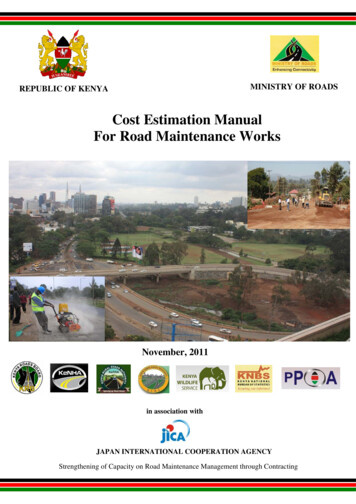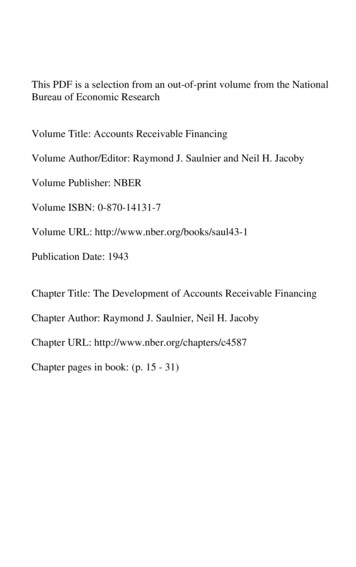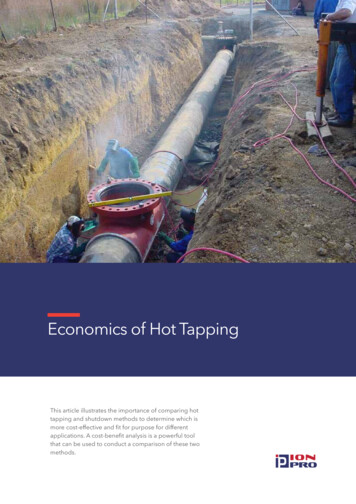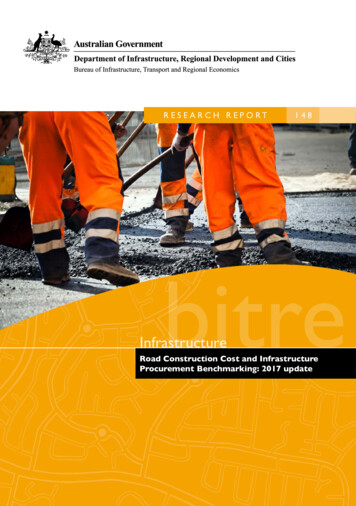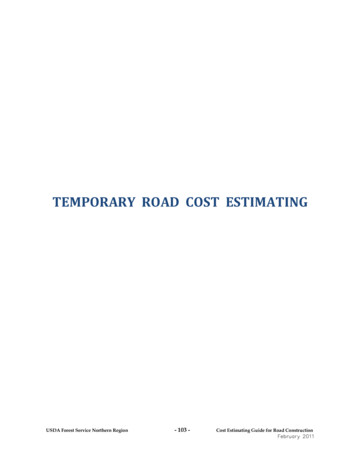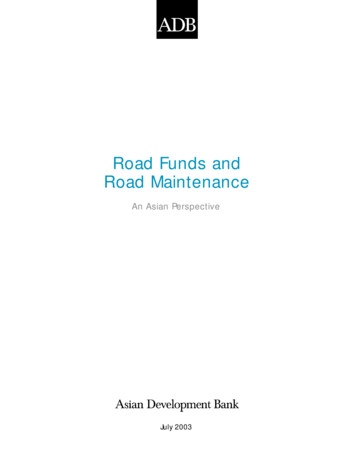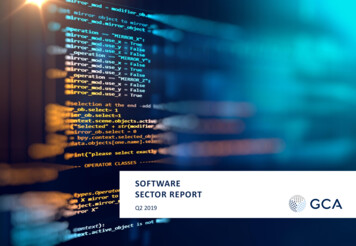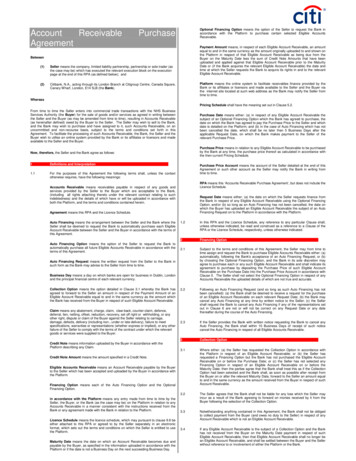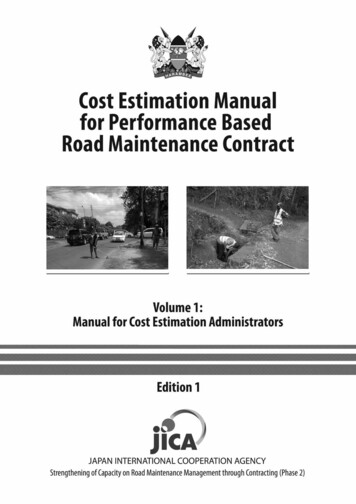
Transcription
COST ESTIMATION MANUALFOR PERFORMANCE BASEDROAD MAINTENANCE CONTRACTVolume I — Manual for Cost Estimation Administrators Japan International Co-orporation AgencyFirst EditionYear of publication 2016NairobiArtwork by John AgutuEmail: agutujo@yahoo.comPrinted by Franciscan Kolbe Press, P.O. Box 468 – 00217 Limuru KENYA
ContentsForeword .vAbbreviations and Acronyms.viGlossary of Terms.vi1.Introduction.11.1 Background and Objectives.11.2. Structure of Cost Estimation Manual.11.3. PBC Works and Instructed Works.21.4. Cost Structure for Estimation.32.1.5. Definition of SRUQ and P/R.Role of Cost Estimation Administrator.553.PDCA Cycle for Cost Estimation.64.Cost Estimation Methods of PBC Works.75.Cost and Other Affiliated Surveys.85.1. Unit Rates.85.1.1. Labour Cost.95.1.2. Vehicle Cost.95.1.3. Fuel Cost.95.1.4. Material Cost.95.2. Survey on 6 Major Labour Based Works.105.2.1. Productivity Survey.105.2.2. Miscellaneous Cost Survey.185.3. Patrol and Self-Inspection (Self-Control Unit) Survey.185.4. Survey on Other PBC Works.205.4.1. Damage Inventory Survey.205.4.2. Percentage Survey.215.4.3. How Survey is Used in Cost Estimation.215.5. Survey on Percentage Add-ons on Indirect Cost and Overhead & Profit.225.6. Survey on Standardized Quantities-for 6 Major Labour Based Works.Analytical Results Based on Surveys Conducted.22266.1. Unit Rates.266.2. SRUQs for 6 Major Labour Based Works.266.3. Data on Percentage Add-ons on Indirect Cost and Overhead & Profit.306.3.1. Indirect Cost.306.3.2. Overhead & Profit.Manual Revisions .30306.7.Volume 1: Manual for Cost Estimation Administratorsiii
ContentsAppendix 1 COST Estimation System 2015 For Cost Estimation Administrators.31Appendix 2 Cost Estimation Parameters 2015.46Appendix 3 Concept of SRUQ / Productivity Rate (P/R).49Appendix 4 Form 1 Site Layout.52Appendix 5 Form 2 Work Record Form.53Appendix 6 Form 3 Productivity Survey Summary Form (Excel).54Appendix 7 Information on Volume 3 for Contractors’ Reference Use.55Appendix 8Training Results for PR Survey done by JICA/KRB in September and October 2015.56Appendix 9Recommendations by KRB on Indirect Cost, Overhead/Profit and Build-up of Unit Rates.92ivCost Estimation Manual for Performance Based Road maintenance contract
ForewordThe concept of performance based contracting in road maintenance and management has been adopted inKenya and was commenced in 2010 on a pilot basis. However, the method of estimating cost of works underperformance based contracts was not clear as it was based on traditional method of road maintenance. It wastherefore noted that a more scientific and accurate way of cost estimation of PBC road maintenance contractsneed to be formulated since these types of contracts differ from the traditional maintenance contracts. Tothis end, JICA under the Project for strengthening of capacity on road maintenance and management throughcontracting (phase 2), embarked on the noble task of developing this manual.The manual has been prepared based on surveys conducted on the ongoing performance based contracts andwide stakeholder consultations. The manual does not only provides scientific method of estimating the cost ofPBC road maintenance works but also provides survey techniques for collection of data necessary for regularupdating of the manuals. The manual consist of three volumes. Volume 1 is tailored to be used by the RoadAdministrator (KRB) who provide estimation parameters and will be in charge of updating of the database. Volume2 will be used by the road authorities for estimation of Project Cost i.e. determining the ceiling price for purposesof budget allocation, planning and tendering. Volume 3 has been prepared specifically for contractors who will beinterested in tendering for PBC works. In volume 3, a deliberate move was taken to exclude information on unitprices and percentages of indirect cost, overheads/profits which the contractors are required to provide duringthe tendering processes. A computer program known as COSTES for PBC 2015 was also developed with datacollected from surveys on the ongoing PBC contracts. The computer program will be used with the manual toease rigorous computation processes. Explanations on how to operate the program have been appended in themanual.It is hoped that this manual will be very useful in implementation of this new concept of road maintenance andwill be beneficial to both the clients and the contractors.I urge all stakeholders to make proper use of the manual in costing of PBC road maintenance works to arrive atmore accurate cost of PBC contracts, thus guaranteeing value for money and best return to the taxpayer.Finally, I recognize and acknowledge with appreciation the National Working Group and Sub-Working Groupmembers who provided their valuable advice through a series of meetings during the period of formulating thismanual. I am particularly grateful to the JICA team for their technical assistance in achieving this milestone andfor their overall assistance in capacity building for road maintenance and management. Special gratitude goes toall road authorities and other government agencies which include KRB, KeNHA, KURA, KeRRA, KWS, KIHBT,NCA and PPOA for their valuable support in the development of this manual.Eng. Patrick MwinziChief Engineer (Roads)Ministry of Transport and InfrastructureVolume 1: Manual for Cost Estimation Administratorsv
Abbreviations and Acronyms / Glossary of termsAbbreviations and AcronymsIMPP/RRARMPSRUQ—————Initial Mobilization PeriodProductivity RateRoad AuthorityRoutine Maintenance PeriodStandard Resource Usage per (Unit) QuantityGlossary of TermsActual QuantityRefers to the actual quantity of work and service for each service criteriaexecuted by the contractor to achieve the specified service level.Simple QuantityRefers to the targeted quantity of work and services for each service criteriato be executed by the contractor as per the contract drawings.General MaintenanceRefers to all works and services (mainly off-carriageway) required to beperformed by the contractor under the performance based contract.Initial Mobilization PeriodThis is the period during the initial stages of the contract when the contractormakes interventions to bring the road to maintainable conditions.Routine Maintenance PeriodThis is the period after the expiry of the initial mobilization period whenthe contractor undertakes routine maintenance activities. The activities areperformed to maintain the performance standards of the road and to achievespecified service levels.viCost Estimation Manual for Performance Based Road maintenance contract
Introduction1. Introduction1.1 Background and ObjectivesPerformance Based Contract (PBC) is a new type of contract, which was introduced in Kenya recently but isincreasingly becoming very common as a contract method for road maintenance. The main payment methodin PBC projects is based on a km-lump sum utilizing set service levels to be achieved by contractors. PBC is aterm contract which covers both the wet seasons when frequent works are required, and the dry seasons whenlesser works may just be sufficient. In spite of the widespread use of PBC’s in road maintenance, no standardcost estimation method has been developed. This creates a situation that no scientifically based judgment can bemade when the Engineer’s cost estimate is very different from the actual tender price.Therefore, the need for development of such standard cost estimation method is vital for sustainable applicationof PBC. Utilizing the standard cost estimation method is one of the basic fundamentals of project management ofPBC’s and will enable staff in various road authorities to have proper understanding of the tender price.This Cost Estimation Manual for Road Maintenance under Performance Based Contract (hereinafter referredto as “the Manual ”)aims to develop a scientific cost estimation method for PBC road maintenance using costbreakdown sheets and standardized estimation procedures.The Manual includes not only how to estimate costs but also provide information on survey methods required forrevisions and updates of various parameters such as the Standard Resource Usage per (Unit) Quantity (SRUQ)and important cost items such as unit rates.The Manual is in line with COST Estimation System for PBC 2015 (hereinafter referred to as “COSTES for PBC2015”), the computer tool used for actual cost estimation exercises.The Manual and COSTES for PBC 2015 are intended for use by engineers and managers who are responsible forroad maintenance in each road authority in Kenya, and who require scientifically based judgment when planningand implementing PBC road maintenance projects.1.2. Structure of Cost Estimation ManualThree (3) Cost Estimation Manuals are prepared according to the purpose and user shown in Table 1-1.Table 1-1 Structure of Cost Estimation ManualsVolName of ManualUserObjectives1Manual for Cost EstimationAdministratorsKRBCost and Affiliated SurveysProvision of Estimation ParametersUpdate and Maintenance of Database and ManualHow to Revise Vol. 2 and 32Manual for Government CostEstimatorsRoadAuthoritiesand KWSEstimation of Project Cost for Budget AllocationEstimation of Project Cost for Tender3Manual for Contractors’Reference & UseContractorsEstimation of Project CostVolume 1: Manual for Cost Estimation Administrators1
Introduction1.3. PBC Works and Instructed WorksAll current PBC projects in Kenya are composed of works and services related to Maintenance Services (hereafterreferred to as the PBC Works) and Instructed Works. Contractors have full responsibilities for works and servicesrequired to bring up the road condition to the specified service levels. Contractors need to assess the existingroad condition and quantify the volume of the works and services required to achieve specified service levels.The PBC Works mainly consists of:1)Labour-based works and services such as repair and maintenance of drainage, vegetation, roadcleanliness, and provision of a Self Control Unit for self management of road maintenance; and,2)Other works and services such as repair and maintenance of the carriageway and shoulders, repair ofstructures, repair on road furniture, profile, width and embankment and slopes.Table 1-2 PBC Works and Instructed WorksWork TypePBC WorksInstructed WorksPayment MethodBased on Km-Monthly Lump SumBased on Bill of QuantitiesInitiatorContractorClientBased on the nature of various requirements, Instructed Works are a combination of the following works andservices as indicated in Table 1-3.Table 1-3 Details of Instructed WorksInstructed WorksBill of QuantitiesPaymentRehabilitation WorksPrepared by the clientUnit ratepaymentdetermined bythe contractorPrepared by the clientUnit ratepaymentdetermined bythe contractorPrepared by the clientUnit ratepaymentdetermined bythe contractor To bring the road up to the pre-defined standards at the startof the PBC project. E.g. filling potholes, laying gravel wearingcourse, repairing carriageway edges, reinstating road camber,road furniture maintenance and repair, and repairing culverts asmay be required.Improvement Works To add new characteristics to the road in response to newtraffic, safety or other conditionsEmergency Works To reinstate the road after damage has occurred as a result ofnatural occurrences with unexpected consequences under thecondition defined in the contractThis Manual has been prepared principally to estimate the cost of PBC Works for which no standard procedurefor cost estimation was addressed in the previously issued “Cost Estimation Manual for Road Maintenance Works2011”, popularly referred to as the COSTES Manual 2011.This Manual is a new edition and focuses exclusively on the PBC Works. It tries to correctly estimate labourbased works and services based on surveys conducted on on-going PBC projects. The Manual therefore reflectsthe result of the surveys and recommends methods of standard estimation procedures using the results obtained2Cost Estimation Manual for Performance Based Road maintenance contract
Introductionfrom PBC projects undertaken in 2014 and 2015.It is important to appreciate that some future projects may be different from those projects surveyed for thepurpose of determining various values incorporated into this Manual. For example, in projects surveyed, therewere no physical repairs of scour checks and headwalls, and no physical maintenance and repair of structuresand road furniture.In such cases, the COSTES Manual 2011 should be used to correctly modify the cost estimation by incorporatingthe additional costs for such physical repairs. Similarly, if a road authority is required to estimate the cost ofInstructed Works in addition to the PBC Works, the COSTES Manual 2011 should be used after correctlyassessing quantities of the Instructed Works required. In order that the Manual is useful for such cases, an attempthas been made to allow adding such costs as deemed necessary from past experience/data, and collection ofestimates for such works, based on prudent judgment of the cost estimator. Default values set out in COSTESfor PBC 2015 may also be used.1.4. Cost Structure for Estimationd) VATTotal Project Cost a b c d16%c) Overhead & Profita) Direct Costb) Indirect CostThe cost structure for estimation is shown in Figure 1-1 and the contents of each cost estimation element areshown in Table 1-4. The project cost consists of four (4) cost components namely; a) Direct Cost, b) IndirectCost, c) Overhead & Profit and d) VAT. The total estimated cost is computed as the summation of all four costcomponents. The project cost is the summation of three cost components excluding VAT.Note: Using the Framework of the COSTES Manual 2011Figure 1-1 Principal Structure of PBC Cost EstimationVolume 1: Manual for Cost Estimation Administrators3
IntroductionTable 1-4 Contents of Cost Estimation ComponentsComponentsCost Estimation ElementsMaintenance costs which are required for the PBC Works such asrepair and maintenance of drainage, vegetation, road cleanlinessand provision of Self Control Unit for self-management of roadmaintenance.Maintenance costs for the PBC Works such as repair of carriagewayand shoulders, repair of structures, repair of road furniture, repair ofroad profile and width, and repair of embankment and slopes.Miscellaneous Costsand OthersMiscellaneous expenses and other costs which are required for properon-site control and provision of safety gears and devices for workersand necessary haulage cost for transporting labour, materials andequipment from/to the site.Indirect CostOther PBC Works Site Management CostSite Staff AllowancesSite Staff Social ChargesGeneral Safety MeasuresHuman Resource Management CostOverhead & ProfitDirect CostOff CarriagewayMaintenance Costs(6 Major Labour BasedWorks and Self ControlUnit) Head Office Management CostHead Office Staff Salaries and AllowancesCooperate Social ChargesResearch and DevelopmentAdvertisement and PublicityDepreciation Costs for Fixed AssetProfit MarginCost computation for these items istaken as a percentage of the Direct CostCost computation for these items is takenas a percentage of the sum of Direct Costand Indirect CostThe structure of a typical project is shown in Figure 1-2 for cost estimation purpose under COSTES for PBC2015. The Direct Cost in this case consists of PBC Works, Instructed Works and Haulage Cost.ItemTotal Project Cost (VAT(16%) Inclusive)12 10 11Project Cost10 7 8 9Direct CostPBC Works43217 4 5 64 1 2 3Patrol and Self Inspection under Road Safety1Major 6 Labor Based Work under Road Durability2Other PBC Works3Instructed Works5Haulage Cost of Major 6 Labor Based Work6Indirect Cost8Overhead & Profit9VAT(16%)Figure 1-2 Cost Estimation Structure under COSTES for PBC 20154CostCost Estimation Manual for Performance Based Road maintenance contract11
Role of Cost Estimation Administrator1.5. Definition of SRUQ and P/RStandard Resource Usage per (Unit) Quantity (SRUQ) is the ratio of the number of person-days divided by thevolume of work completed. On the other hand, Productivity Rate (P/R) is an inverse of SRUQ.An example of SRUQ and Productivity Rate is illustrated in Figure 1-3.Example:Grass cutting of 10,000m2 is completed in 5 man-days. That is 5 persons each completing 2,000m2 on a given day.SRUQ 5 man-days/ 10,000 m2 0.0005 man-day/m2Productivity Rate (P/R) 2,000m2 / man-dayFigure 1-3 SRUQ and P/R2. Role of Cost Estimation AdministratorThe roles of a cost estimation administrator are as follows:1Conducting surveys on costs, establishing standard costs and updating of costs annually;2Conducting surveys on productivity, establishing productivity indices and updating of productivityindices; and,3Management and updating of the Cost Estimation ManualVolume 1: Manual for Cost Estimation Administrators5
Role of Cost Estimation AdministratorTable 2-1 gives the Plan, Do, Check, Action (PDCA) cycle for cost estimation related activitiesTable 2-1 PDCA Cycle for Cost Estimation Related ionC (Check)CostSurveyRoadAuthoritiesFrequencyUnit Rates SurveyIndirect Cost andOverhead & ProfitSurveys(Coordination andreferral with KNBS1index, etc)Productivity SurveySRUQ(by work item)SRUQ(by RoadAuthority)Every YearKRBEvery YearA (Action)Manual Update (See 2.2)Every YearP (Plan)Planning the budget for next year projectsEvery YearD (Do)Cost Estimation for the projectEvery YearKeNHA,KURA,KeRRA, KWSNote) SRUQ : Standard Resource Usage per (Unit) Quantity3. PDCA Cycle for Cost EstimationScientific cost estimation is based on utilizing data collected from actual road maintenance sites. The Manualshould therefore be revised periodically so that data used are always current. Hence, the PDCA (Plan-DoCheck-Action) cycle is introduced to express this periodic updating process. This process is to improve thequality of the Manual by accumulation of basic data.Figure 3-1 shows the Cost Estimation PDCA Cycle Schedule.20152016July to FebFieldsurvey3456Cost Data CollectionJuly to Feb201734567Cost Data CollectionDataanalysisAManualRevisionManual revisionactivityManual revisionactivityNew for eachcontractUsing 2015 manual2015 manualUsing 2016 manual2016 manualFigure 3-1 Cost Estimation PDCA Cycle Schedule6Cost Estimation Manual for Performance Based Road maintenance contract2017B
Cost Estimation Methods of PBC Works4. Cost Estimation Methods of PBC WorksCost estimation is performed in two stages.The first stage involves cost estimation of the PBC Works. Thecontents of the PBC Works maybe split into three (3) categories as indicated in Table 4-1 based on cost elementsinvolved. The details of the Six (6) Major Labour-Based Works are indicated in Table 4-2.Compatibility of such three categories in respect to the specific service scope are indicated in Table 4-3.The second stage requires estimating the cost of the Indirect Cost and the Overhead & ProfitTable 4-1 PBC WorksNo CategoriesDescriptionCost Element16 Major Labour-Based WorksEssentially the work is labourbased and off-carriagewayactivity.Labour cost only. Vehicle and fuelcosts are included in Haulage Cost.2Patrol and Self-Inspection (Self For patrolling under RoadControl Unit)Usability and for self-inspection.Labour, vehicles and fuel costs.3Other PBC WorksLabour, materials, machineries andequipment. Vehicle and fuel costsare included in Haulage Cost.Works involving the carriagewayand others.Table 4-26 Major Labour-Based WorkNoItem1Grass Cutting2Cross Culvert De-silting3Catch Basin De-silting4Lined Side Ditch De-silting5Unlined Side Ditch De-silting6Carriage Way CleaningTable 4-3Compatibility of the PBC Works and Service Scope6 Major Labour Patrol and SelfBased WorksInspectionCategoryService ScopeRoad UsabilityA) Road UsabilityRoad UserComfortB) Pavement, Shoulders and ROW forPaved Roads (P-B-1) & Unpaved Roads(UP-B-2)Road DurabilityOther PBCWorksOO(Cleanliness) C) DrainageO D) VegetationO O(repairingitems)E) Structures OF) Road Furniture OG) Profile and Road width OH) Embankment and slopes OVolume 1: Manual for Cost Estimation Administrators7
Cost and Other Affiliated Surveys5. Cost and Other Affiliated SurveysThis section covers cost surveys and other affiliated surveys, such as the productivity survey and the road facilitiessurvey which are required for updating the Manual by the cost estimation administrator.1)2)3)4)5)6)Unit Rates6 Major Labour Based Works (Productivity)Self Control UnitOther WorksPercentages Based Indirect Cost, and the Overhead & ProfitRoad Facilities (Survey for Assessing Associated Facilities Required for Maintenance)Table 5-1 List of Cost SurveysNoCost SurveysPurposes1Unit RatesFor determining standard unit rates26 Major Labour Based WorkFor determining productivity parameters. P/Rs3Patrol and Self Inspection (Self Control Unit) For determining productivity parameters4Other PBC WorksFor determining standard work informationFor determining standard work quantitiesFor determining productivity parameters5Indirect Cost, Overhead & ProfitPercentagesFor determining standard indirect cost percentagesFor determining standard overhead & profit percentages6Road Facilities (Survey for AssessingAssociated Facilities Required forMaintenance)For assessing quantities of associated facilities required formaintenance5.1. Unit RatesThe unit rates survey is conducted by the cost estimation administrator so that each road authority may usestandard unit rates for the cost estimation purpose.Unit rates for material, labour and machineries used for cost estimation by road authorities are basically derivedfrom official price information provided by several government offices. They are open to public and are based onnation-wide market surveys. Hence they can be assumed to be the average rates in Kenya. They include: Material Rates: Material Price List from Kenya National Bureau of Statistics (KNBS) Fuel Rates: Pump Price List from Energy Regulatory Commission, the Ministry of Energy. Labour Rates: The Regulation of Wages (General) (Amendment)Order, The Labour InstitutionAct, the Ministry of Labour Machinery Rates: Equipment Hire Rate List from Mechanical and Transport Department, theMinistry of Transport and InfrastructureAll labour, material and machinery rates should be surveyed by regions; big cities (example: Nairobi, Mombasaand Kisumu) and all others.Rates may be updated in an ad-hoc basis when substantial change takes place during the fiscal year (e.g. in caseof high inflation or embargo).When some of material and machinery rates are not covered in official documents, average market rates acquired8Cost Estimation Manual for Performance Based Road maintenance contract
Cost and Other Affiliated Surveysfrom surveys by the cost estimation administrator or provisional rates by referring to similar items may be used.However, those rates should be revised immediately the official rates become available.For cost estimation using the Manual, collection of the unit rates indicated in Table 5-2 is required. These unitrates apply for 6 Major Labour Based Works and Self Control Unit (Patrol and self-inspection), but these are notapplicable to the Other PBC Works.Table 5-2 Unit Rates for Cost EstimationNo123CategoryLabour CostVehicle CostFuel isorsKSH/monthSCU LeaderKSH/monthSCU InspectorKSH/monthDriverKSH/monthPatrol CrewKSH/monthTruckKSH/monthPick upKSH/monthDiesel, arks5.1.1 Labour CostThe unit rate for labourers will be determined based on the current regulation issued by the Ministry of Labouron minimum wages. The minimum wage will be used. The unit rates for Labour Costs (excluding Labourers)indicated in Table 5-1 will be determined by conducting Workers’ Wage Survey to check prevailing rates for eachposition. Adequate data will be collected and the average value will be used as the unit rates for each workercategory. In case drastic regional disparity exists, adjustment will be made to compensate for such disparity incertain regions.5.1.2. Vehicle CostThe unit rate (dry hire rate) for vehicles will be determined based on availability in the market. Adequate datawill be collected and the average value used as the unit rate. This survey may be supplemented by conducting asurvey on firms who own a fleet of vehicles on purchase basis and who apply a yearly depreciation cost as thevehicle cost. In this case also, adequate data will be collected and the average value used as the unit rate.5.1.3. Fuel CostThe unit rate for fuel will be determined based on use of the latest Pump Price List issued by the EnergyRegulatory Commission.5.1.4. Material CostSix (6) Major Labour Based Works do not have material costs. However, the Other PBC Works require unit ratessurvey to determine various materials required for works.Owing to variation in rates according to the location of the project, the result of the material cost survey mustbe compiled according to regions. Adequate data will be collected and the average value used as the unit rate.Volume 1: Manual for Cost Estimation Administrators9
Cost and Other Affiliated Surveys5.2. Survey on 6 Major Labour Based WorksThe survey on 6 Major Labour Based Works is conducted by the cost estimation administrator so that each roadauthority may use productivity parameters for the cost estimation purpose.These are the Productivity Survey (SRUQ Survey and the Work Frequency Survey).5.2.1. Productivity SurveyThe Productivity Survey is conducted and the result is compiled for each road authority by the cost estimationadministrator.5.2.1.1Survey ProcedureIn order to obtain precise cost estimation, it is important to understand the precise volume of work inputs suchas labour, materials and equ
for cost estimation was addressed in the previously issued “Cost Estimation Manual for Road Maintenance Works 2011” , popularly referred to as the COSTES Manual 2011. This Manual i
